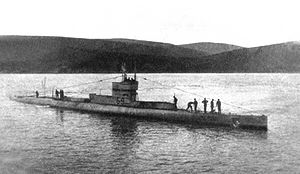HMS G10

 A G-class submarine before bow modification. | |
| History | |
|---|---|
| Name | G10 |
| Builder | Vickers |
| Laid down | 12 March 1915 |
| Launched | 11 January 1916 |
| Commissioned | 12 April 1916 |
| Fate | Sold, 20 January 1923 to J Smith |
| General characteristics | |
| Class and type | G-class submarine |
| Displacement |
|
| Length | 187 ft 1 in (57.0 m) |
| Beam | 22 ft 8 in (6.9 m) |
| Draught | 13 ft 4 in (4.1 m) |
| Installed power |
|
| Propulsion |
|
| Speed |
|
| Range | 2,400 nmi (4,400 km; 2,800 mi) at 12.5 kn (23.2 km/h; 14.4 mph) surfaced |
| Complement | 30 |
| Armament |
|
HMS G10 was a British G-class submarine built for the Royal Navy during World War I.
Description
[edit]The G-class submarines were designed by the Admiralty in response to a rumour that the Germans were building double-hulled submarines for overseas duties. The submarines had a length of 187 feet 1 inch (57.0 m) overall, a beam of 22 feet 8 inches (6.9 m) and a mean draft of 13 feet 4 inches (4.1 m). They displaced 703 long tons (714 t) on the surface and 837 long tons (850 t) submerged. The G-class submarines had a crew of 30 officers and ratings. They had a partial double hull.[1]
For surface running, the boats were powered by two 800-brake-horsepower (597 kW) Vickers two-stroke diesel engines, each driving one propeller shaft. When submerged each propeller was driven by a 420-horsepower (313 kW) electric motor. They could reach 14.25 knots (26.39 km/h; 16.40 mph) on the surface and 9 knots (17 km/h; 10 mph) underwater. On the surface, the G class had a range of 2,400 nautical miles (4,400 km; 2,800 mi) at 16 knots (30 km/h; 18 mph).[1]
The boats were intended to be armed with one 21-inch (53.3 cm) torpedo tube in the bow and two 18-inch (45 cm) torpedo tubes on the beam. This was revised, however, while they were under construction, the 21-inch tube was moved to the stern and two additional 18-inch tubes were added in the bow. They carried two 21-inch and eight 18-inch torpedoes. The G-class submarines were also armed with a single 3-inch (7.6 cm) deck gun.[1]
Construction and career
[edit]Like the rest of her class, G10's role was to patrol an area of the North Sea in search of German U-boats. While on exercises, the submarine collided with a merchant vessel resulting in the destruction of the bridge and the periscopes.[2] On 3 June 1916, following the Battle of Jutland, HMS Titania instructed G10 to locate and sink floating remains of Invincible to prevent the capture of materials.[3] The submarine survived the war, and was sold for scrap in 1923.
Notes
[edit]References
[edit]- Colledge, J. J.; Warlow, Ben (2006) [1969]. Ships of the Royal Navy: The Complete Record of all Fighting Ships of the Royal Navy (Rev. ed.). London: Chatham Publishing. ISBN 978-1-86176-281-8.
- Gardiner, Robert & Gray, Randal, eds. (1985). Conway's All the World's Fighting Ships 1906–1921. Annapolis, Maryland: Naval Institute Press. ISBN 0-85177-245-5.
- McCartney, Innes (2008). British Submarines of World War I. New Vanguard. Vol. 145. Oxford, UK: Osprey. ISBN 978-1-84603-334-6.